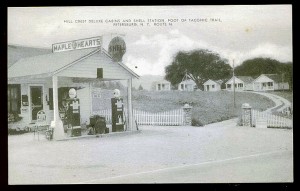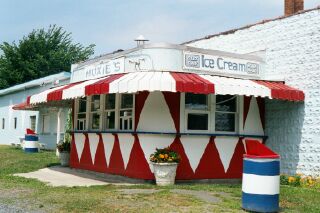The Story of Roadside Fan #5501
Who I am, and why I’m fascinated with the great American roadside
Part one: An early fan
I, Glenn Wells, am RoadsideFan number 5501. That’s using the same numbering scheme that Silk City Diners used prior to 1960, combining the last two digits of the year with the sequence number for that year. In other words, I am the first RoadsideFan born in 1955. This might be an exaggerated claim, but many of the other roadside enthusiasts I know are either older or younger. More importantly, I know that I have been a RoadsideFan all my life.
My mother recalls that as a very small child, I would be extremely fussy on a car trip. When I got big enough to see out of the car window, the fussing stopped. I could now view what Chester Liebs aptly labeled “the movie through the windshield.” Full color in an era when television was black and white. Three-dimensional. Lots of signs to read out loud. And particularly fascinating at night, with signs and buildings awash in neon.
Two of the first highways I got to know were New York Routes 2 and 7, which both headed east from our home in Troy, New York. Route 2 was the road to Grandma’s house, a hilly journey over Grafton Mountain. When I saw Hillcrest Cabins in Petersburg, a row of neat white buildings with red roofs, I knew the trip was almost over. Hillcrest had a tea room, and Mobil gasoline pumps out front. I only wish that I had thought to snap a picture.

This early postcard image of Hillcrest Cabins in Petersburg, NY was sent to me by a visitor to the RoadsideFans web site. By the 1960s they had added a concrete block garage and were selling Mobil instead of Shell gasoline.
Route 7 was a more heavily traveled road, so it had plenty of motels and other roadside businesses spaced out every couple of miles. I could count down the miles to my aunt’s house by watching them flash by. Goyer’s Hillside Motel. Two Acres Motel. Sun Deck Motel. Dave Victor’s Restaurant. The Beauty Spot. Moon Wink Motel. Lake Lorraine Park. All of them are gone now, but in some cases the buildings remain.
Even as a child, I would notice certain things about roadside buildings. That Mobil station miles away looked just like the one Dad went to near home: a gleaming white cube with a giant winged horse appearing to leap off the roof. You also knew that they had “clean rest rooms” – after all, the sign said so! You could also depend on them having a Coke machine, where for one thin dime you could get a refreshing drink.
Probably the first diner I ever went to was one near our home in Troy – the Sycaway Diner. I sort of recall it being yellow porcelain sided with red trim, which might have made it a Sterling. The diner was full of fascinating things that you did not see at home or in other buildings – a counter with stools that spin around, booths with coat trees on the ends, and a jukebox where you could insert a dime, press a number and a letter, and hear any song you wanted. The Sycaway Diner was removed about 1965 to make way for a dry cleaning place, which is still there today.
Our family would also eat at drive-ins, such as Tom’s Snack Bar at the end of Oakwood Avenue. This was a small wooden cube of a building, but they had car hops who would bring out a tray and you would eat in your car! As a child, this seemed even cooler than eating in a diner, and such a place would never heap canned vegetables on my plate that I would then be expected to eat. There was a small amusement complex near Tom’s, “Miami Beach,” which became the site of Troy’s new water filtration plant but its merry-go-round (the portable county fair kind) continued to operate for a few years after the plant was opened. Today, both Tom’s and the merry-go-round are long gone.

When I was a child, this place looked exactly the same except it was Wagar’s and all white. It’s been Moxie’s since 1969, and they still make all of their own ice cream.
And then, of course, there was ice cream! We’d take a drive “out in the country” to Wagar’s Dairy (still serving ice cream today as Moxie’s) or go to the Lansingburgh section of Troy to Dairy Queen (now mansardized and converted to a Chinese restaurant) or the Snow Man (still there in all its vintage glory.)
The era in which I was taking in all these sights was a very exciting one for roadside architecture. This was the Space Age, and plenty of flashy buildings with soaring rooflines, stone facings, and huge expanses of glass were being built. I noticed that all the new buildings had back-lit plastic signs, so this must be what was modern and neon must be out of date. Likewise, the Howard Johnson’s restaurants we would sometimes visit seemed sparkling new and clean compared to the diner back home. The futuristic buildings of the New York World’s Fair captured my imagination, and I finally got to see the place in a one day whirlwind with my family in 1965. And if anybody had asked me what I wanted to be when I grew up, without hesitation I would have answered that I wanted to be an architect.
Of course, things change over the years. Soon enough, the flashy Space Age buildings were the ones that seemed old. New roadside buildings were being built with cedar shake mansard roofs and walls of used brick. I became a teenager and abandoned my early dream of becoming an architect to go into electronics instead. My fascination with buildings, though, never stopped. To this day, I will notice some detail about a building that I like and talk excitedly about it. My wife, Susan, will respond, “You should have been an architect.” Maybe so, but had I not become the next Frank Lloyd Wright or Frank Gehry, I might have ended up churning out drive-through pharmacies for some corporate client.
Over the years, I took plenty of day trips and vacations by car. I knew I preferred the food at an independent roadside place over what you could get at McDonald’s, but I probably did not give that much thought to the buildings themselves. They were always there, and I figured they always would be.
